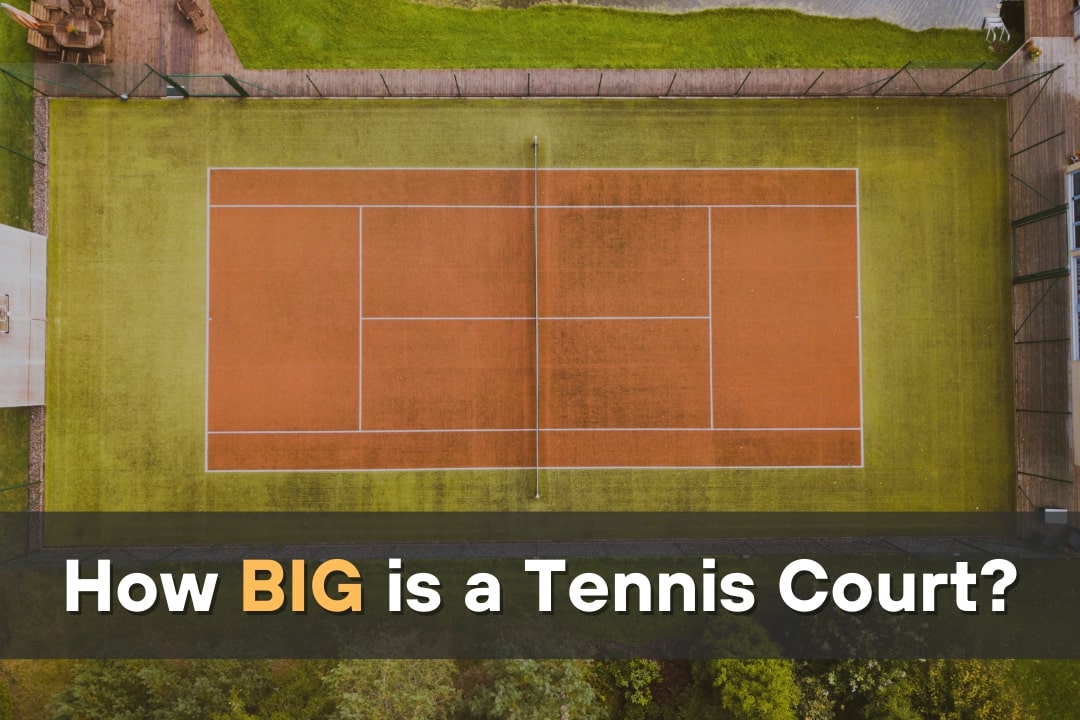Have you ever wondered about the size of a tennis court? Or perhaps, you are thinking of building one yourself? There is an official guideline set by the International Tennis Federation (ITF) for the proper exact measurement of a tennis court. So, a tennis court can’t just be in some approximate dimensions.
So, how big is the tennis court?
The dimensions of a tennis court, set by the International Tennis Federation (ITF), are 78 ft (23.77 m) long & 27 ft (8.23 m) wide, totaling 2106 sq ft (195.7 sq m) for singles court. For doubles court, the dimension is 78 ft (23.77 m) long & 36 ft (10.97 m) wide, totaling 2808 sq ft (260.9 sq m).
This article will break down the dimensions of the areas and lines of a tennis court, as well as the minimum space required around the court. Knowing these can also optimize your tennis gameplay, so don’t miss it!
Table of Contents
Singles Tennis Court Dimensions
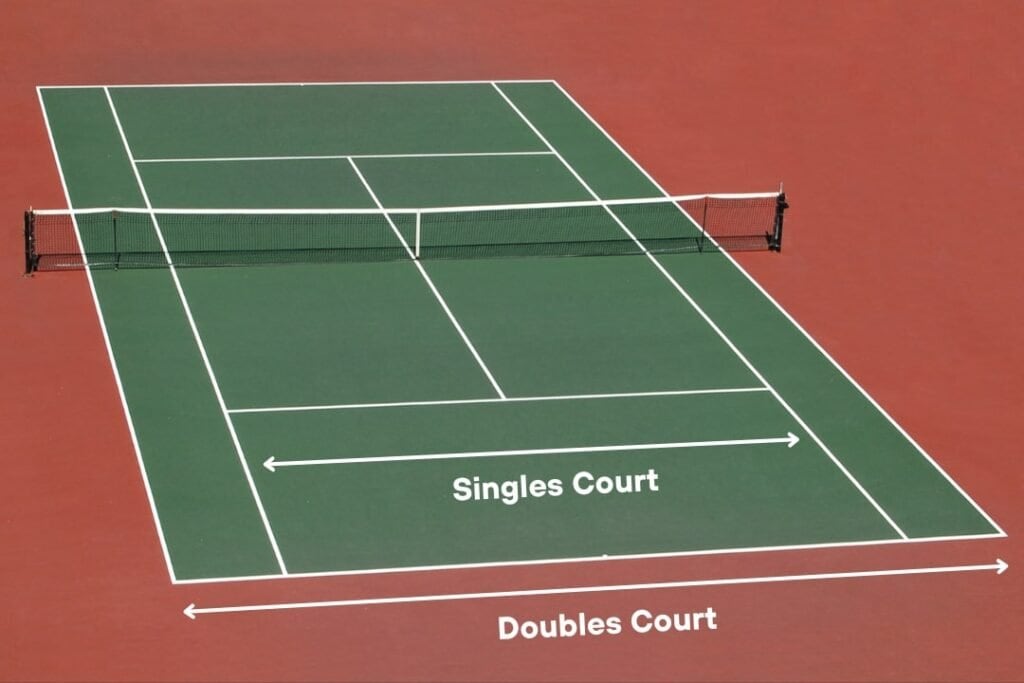
Here are the requirement for singles tennis court dimensions set by the International Tennis Federation (ITF):
| Dimension | Feet (ft) | Inches (in) | Meters (m) | Centimeters (cm) | Yards (yd) |
| Length | 78 ft | 936 in | 23.774 m | 2377.4 cm | 26 yd |
| Width | 27 ft | 324 in | 8.23 m | 823 cm | 9 yd |
| Total Area | 2106 sq ft | 303,264 sq in | 195.7 sq m | 1,956,600 sq cm | 233 sq yd |
The tennis court dimension in feet is 78 feet long and 27 feet wide for singles, with a surface area of 2106 square feet.
The tennis court dimension in meters is 23.77 meters long and 8.23 meters wide for singles, with a surface area of 195.7 square meters.
The tennis court dimension in yards is 26 yards long and 9 yards wide for singles, with a surface area of 233 square yards.
These are the dimensions in the playing area of a singles court, and apply to all kinds of court surfaces, including grass, hard, carpet, concrete or clay courts.
Doubles Tennis Court Dimensions
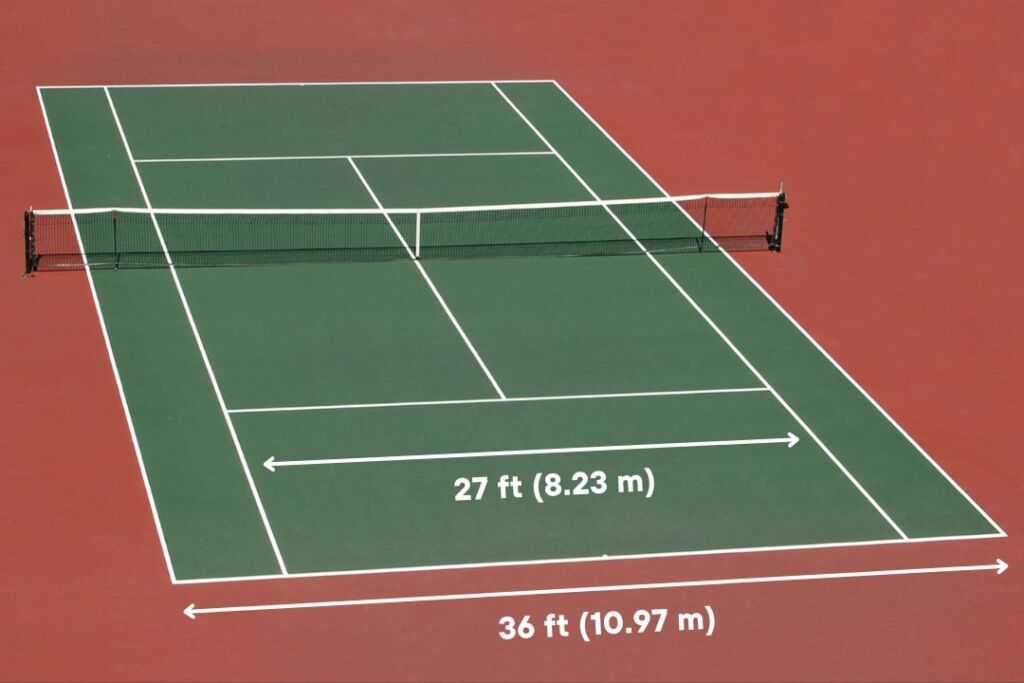
Here are the requirement for doubles tennis court dimensions set by the International Tennis Federation (ITF):
| Dimension | Feet (ft) | Inches (in) | Meters (m) | Centimeters (cm) | Yards (yd) |
| Length | 78 ft | 936 in | 23.774 m | 2377.4 cm | 26 yd |
| Width | 36 ft | 432 in | 10.973 m | 1097.3 cm | 12 yd |
| Total Area | 2808 sq ft | 416,016 sq in | 260,872 sq m | 2,608,721 sq cm | 312 sq yd |
The tennis court dimension in feet is 78 feet long and 36 feet wide for doubles, with a surface area of 2808 square feet.
The tennis court dimension in meters is 23.77 meters long and 10.973 meters wide for doubles, with a surface area of 260.97 square meters.
The tennis court dimension in yards is 26 yards long and 12 yards wide for doubles, with a surface area of 312 square yards.
These are the dimensions in the playing area of a doubles court, and apply to all kinds of court surfaces, including grass, hard, carpet, concrete or clay courts.
Tennis Court Diagrams
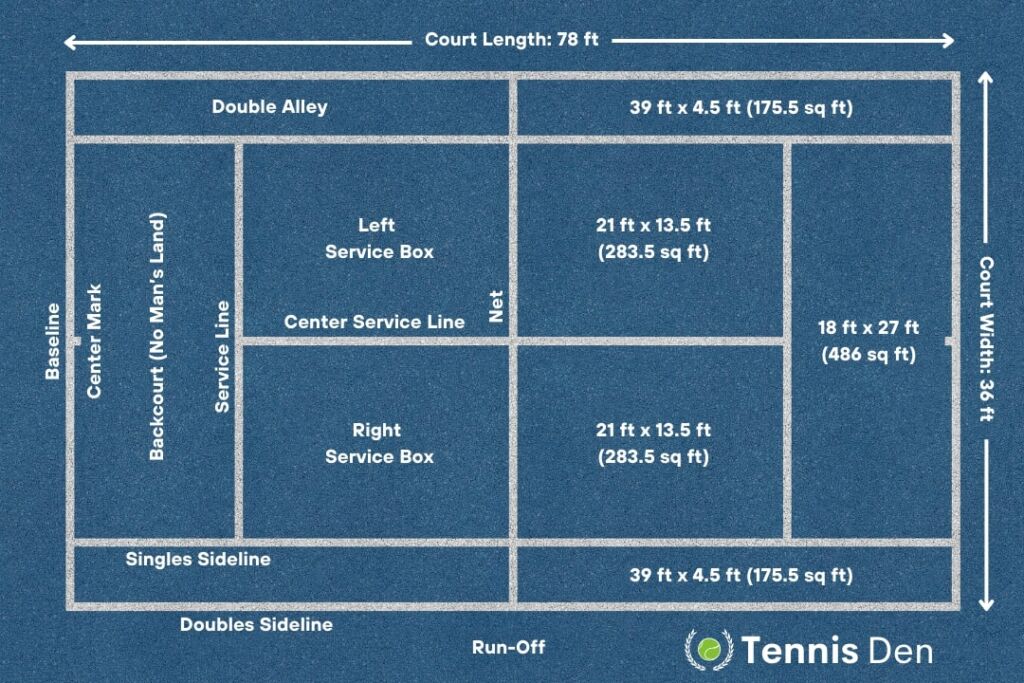
Tennis Court Lines
Baseline
The baseline is the line furthest from the net, located on the back of the court on each side parallel to the net. This line defines the end of the court’s playing area, meaning balls that land outside this line are considered an “out”.
The length of a tennis court baseline is 27 feet (8.23 m) for singles and 36 feet (10.97 m) for doubles.
The baseline has a thickness width of about 1-4 inches (2.5 cm – 10 cm).
Center Mark
A center mark is the small line in the middle of the baseline that divides the court into two halves. It marks the center of the court, and acts as a guide to determine where a player stands when serving. The center mark is 4 inches (10.16 cm) long.
The center mark has a thickness width of 2 inches (5 cm).
Service Line
The service line is the line halfway between the net and the baseline. It marks the length of the service box, the area where serves go into. A serve has to land inside the service box to be counted, landing beyond the line is considered an “out”. The length of a service line is 27 feet (8.23 m).
The center service line is the line that separates the right and left service box, right in the middle and perpendicular to the service line. If measured from the service line to the net, it should have a length of 21 feet (6.40 m).
The service line has a thickness width of 2 inches (5 cm).
Singles Sidelines
The singles sidelines is the line that limits the playing area of a singles court, located on each side of the court, perpendicular to the baseline and the net. Each single sideline is 39 feet (11.89 m) long, measured from the baseline to the net.
Doubles Sidelines
The doubles sidelines are the line that limits the playing area of a doubles court. It has the same length as single sideline of 39 feet (11.89 m) long, also measured from the baseline to the net.
The Singles and doubles sidelines should have a thickness width between 1 inch (2.5 cm) to 2 inch (5 cm).
Tennis Court Areas
Service Boxes
The service boxes are the areas where the serve ball has to land, ball landing outside the service boxes is considered an “out”. Each service box is 21 feet (6.4 m) long and 13.5 feet (4.05 m) wide, making each surface area of 283.5 sq feet (26.34 sq m).
Backcourt (No Man’s Land)
The backcourt is the area between the service line and the baseline. This area is also called the no man’s land because the area is generally avoided by players.
Many instructors and coaches consider standing in the area a less efficient spot as It is too close to the net for a groundstroke and not close enough for a volley. A returned ball is also more likely to land in this area, which can fall on you if you are standing in the area, resulting in a difficult shot for you.
The no man’s land area is 18 feet (5.49 m) long and 27 feet (8.23 m) wide, making the surface area to be 486 sq feet (45.15 sq m).
Double Alleys
The double alley is the space between the singles and doubles sideline. These are not played on singles game, as it is only playable area for a doubles court. Each double alley is 39 feet (11.89 m) long and 4.5 feet (1.37 m) wide, making the surface area to be 175.5 sq feet (16.30 sq m).
Tennis Court Essentials
Tennis Net
A tennis net is a required part inside a court to play tennis properly. According to the ITF guidelines, a tennis net should be 42 ft (12.8 m) long, 3.5 ft (1.07 m) high at the posts and 3 feet (0.91 m) in the center.
Learn more about tennis net height here.
Fencing
Outdoor tennis courts usually need fence around the court, to prevent balls from leaving the area and to play in private.
The minimum height of fences in residential courts is 8 feet (2.438 m) and 10 feet (3.048 m) high for clubs or parks.
How Much Space Do You Need to Build a Tennis Court?
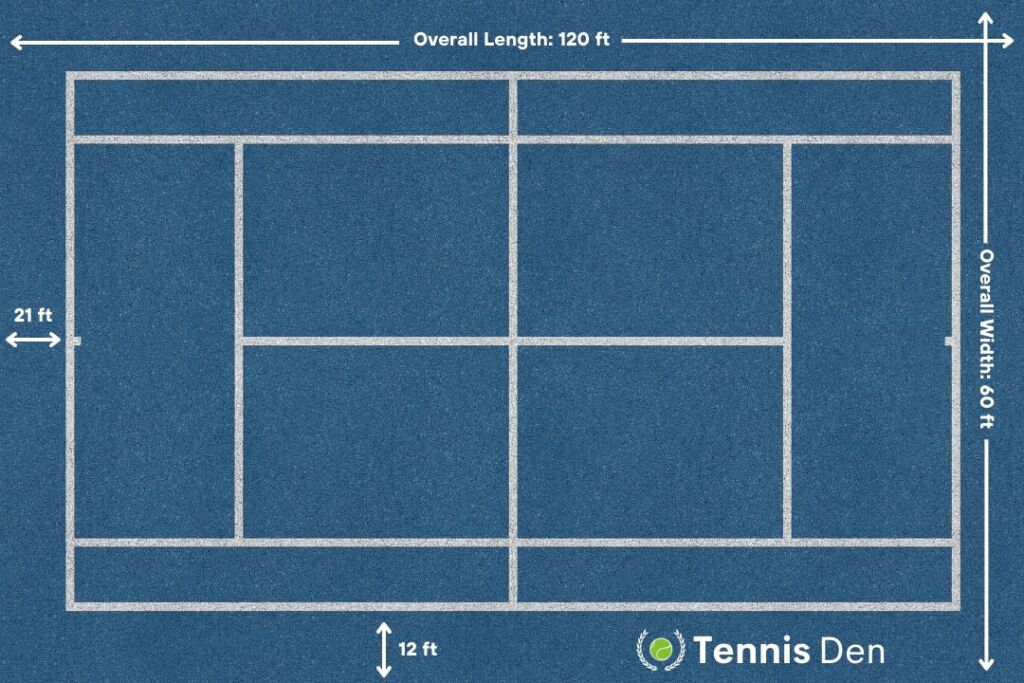
A tennis court also needs space outside the playing area, since players occasionally step outside the playing area to reach the ball. At club levels this is so you don’t run into a fence. In tournaments, the space is needed to accomodate benches, umpires and ball people.
The ITF has a guideline for a minimum amount of space needed around a tennis court, depending on the purpose of the court.
| Court | Overall Length | Overall Width | Overall Area | Behind Baseline | Side of Court | Between Courts |
| Recreational (minimum) | 114 ft (34.8 m) | 56 ft (17.1 m) | 6384 sq ft (593 sq m) | 18 ft (5.49 m) | 10 ft (3.05 m) | 12 ft (3.66 m) |
| International (minimum) | 120 ft (36.6 m) | 60 ft (18.3 m) | 7200 sq ft (669 sq m) | 21 ft (6.40 m) | 12 ft (3.66 m) | – |
| International (recommended) | 132 ft (40.2 m) | 66 ft (20.1 m) | 8712 sq ft (809 sq m) | 27 ft (8.2 m) | 18 ft (4.6 m) | – |
For recreational clubs courts, it should have:
- Minimum space behind baseline is 18 feet (5.49 m)
- Minimum space on each side of the court is 10 feet (3.05 m)
- Minimum overall court length of 114 feet (34.8 m)
- Minimum overall court width of 56 feet (17.1 m)
- Minimum overall court surface area of 6384 sq feet (593.09 sq m)
For official/international tournaments courts, it should have:
- Minimum space behind baseline is 21 feet (6.40 m)
- Minimum space on each side of the court is 12 feet (3.66 m)
- Minimum overall court length of 120 feet (36.6 m)
- Minimum overall court width of 60 feet (18.3 m)
- Minimum overall court surface area of 7200 sq feet (668.9 sq m)
These are the minimum requirement, how about what dimensions are recommended?
The recommended space for international tournaments:
- Behind baseline: 27 feet (8.2 m)
- Side of court: 18 feet (4.6 m)
- Overall length: 132 feet (40.2 m)
- Overall Width: 66 feet (20.1 m)
- Overall Court Area: 8712 sq feet (809.37 sq m)
For indoor tennis courts, the ITF requires the ceiling to have a minimum height as well. The height is measured from the net, starting from the surface to the ceiling, which should be 29.6 feet (9.0 m), 18.86 feet (5.75 m) above the baseline, and 13.12 feet (4.0 m) above the rear for recreational courts.
For tournaments, the minimum height of the ceiling to the surface is 40 feet (12.19 m).
Space Between Other Courts
If you are building multiple tennis courts in an area and want to place each tennis court right beside each other, you need to have a minimum space between the courts.
The minimum space between each court is 12 feet (3.66 m). The recommended space between each court is 24 feet (7.32 m).
Grand Slam Tennis Court Size
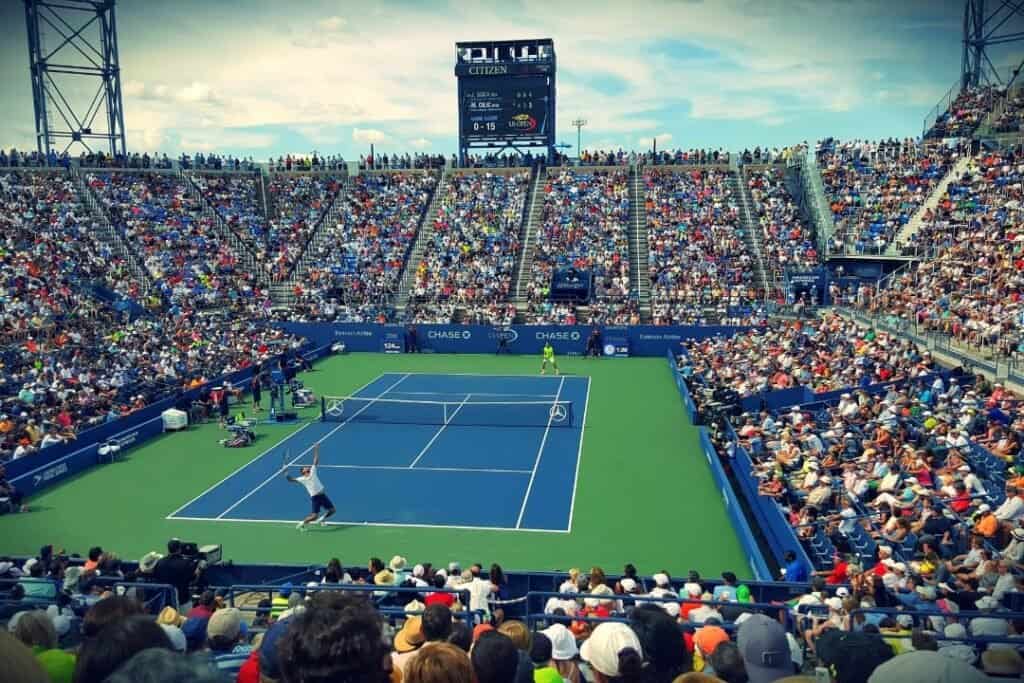
All Grand Slam Courts, Wimbledon, Australia Open, U.S Open, and French Open have a standard court size of 78 ft (23.77 m) in length and 36 ft (10.97 m) in width, with a playing area of 2808 ft.
Whether it is grass, clay, hard, or indoor, every court has the same standard full-sized dimension.
The difference is in the spaces around the sides and back, which are significantly larger than a standard court, in order to accommodate umpires, benches, and ball people.
Each grand slam also has different run-off sizes from each other.
| Grand Slam | Run-off (sidelines) | Run-off (baseline) | Total Length | Total Width | Total Area |
| Australian Open | 25 ft (7.62 m) | 32.97 ft (10.05 m) | 143.94 ft (43.87 m) | 86 ft (26.21 m) | 12,378 sq ft (1150 sq m) |
| French Open | 21.03 ft (6.41 m) | 31.99 ft (9.75 m) | 141.98 ft (43.28 m) | 78.06 ft (23.79 m) | 11,082 sq ft (1029 sq m) |
| U.S. Open | Left side: 25 ft (6.41 m) Right side: 17 ft (5.18 m) | 27 ft (8.23 m) | 132 ft (40.234 m) | 78 ft (23.77 m) | 10,296 sq ft (956.5 sq m) |
| Wimbledon | 22.01 ft (6.71 m) | 27 ft (8.23 m) | 132 ft (40.234 m) | 80.02 ft (24.39 m) | 10,563 sq ft (981.3 sq m) |
U.S Open has the smallest overall court size, while Australian Open has the largest court size out of the 4 grand slams.
Dimensions of a Tennis Court For Kids
Junior tennis in the USTA is a program for children ages 10 and under. The program is divided into four divisions, red, orange, green, and yellow.
In the red division, the tennis court dimension is 36 feet (10.97 m) long and 18 feet (5.49 m) wide, which is around 25% the size of a standard tennis court. The net height is also reduced to 2 feet 9 inches (0.88 m). No doubles are played in this division.
In the orange division, the court increased in size to 60 feet (18.28 m) long and 21 feet (6.40 m) wide for singles and 60 feet (18.28 m) long and 27 feet (8.22 m) wide for doubles. The net height also increases to 3 feet (0.91 m).
The green and yellow divisions use the standard full-sized tennis court dimensions.
| Division | Singles | Doubles |
| Red | 36 ft (10.97 m) x 18 ft (5.49 m) | – |
| Orange | 60 ft (18.28 m) x 21 ft (6.40 m) | 60 ft (18.28 m) x 27 ft (8.22 m) |
| Green & Yellow | 78 ft (23.77 m) x 27 ft (8.23 m) | 78 ft (23.77 m) x 36 ft (10.97 m) |
Other Racket Sport Court Size
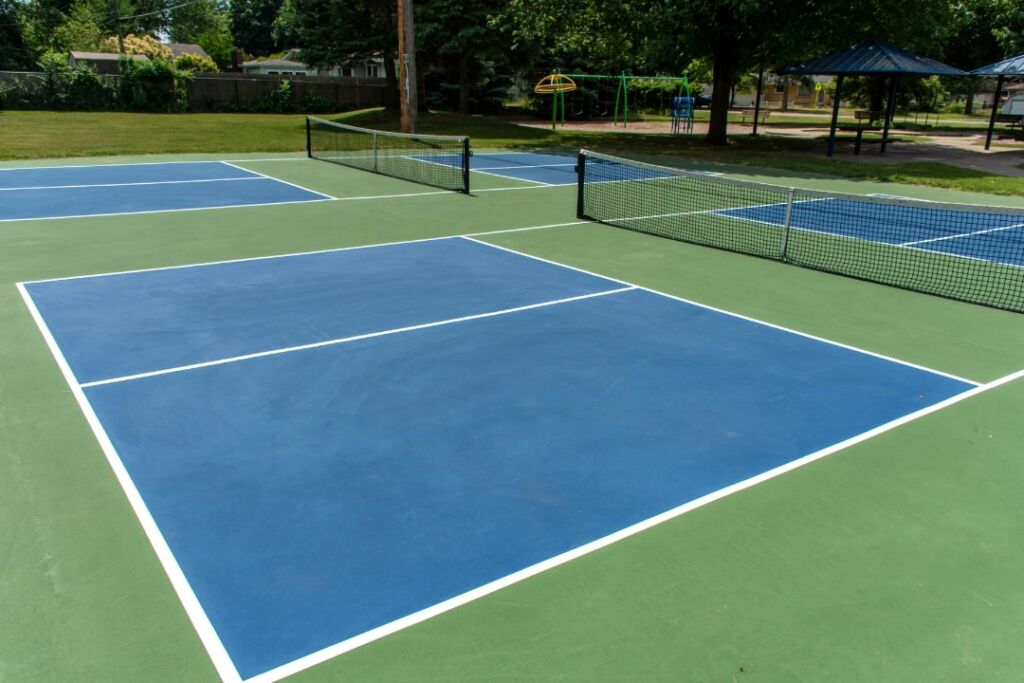
Let’s compare court dimensions of tennis with other racket sport (pickleball, paddle tennis, beach tennis, badminton and volleyball).
| Racket Sport | Length | Width | Total Area |
| Tennis | 78 feet (23.77 m) | 36 feet (10.97 m) | 2808 sq ft (260.9 sq m) |
| Pickleball | 20 feet (6.1 m) | 44 feet (13.41 m) | 880 sq ft (81.75 sq m) |
| Paddle Tennis | 20 feet (6.1 m) | 10 feet (3.05 m) | 200 sq ft (18.58 sq m) |
| Beach Tennis | 52 feet (15.8 m) | 26 feet (7.9 m) | 1352 sq ft (125.6 sq m) |
| Badminton | 44 feet (13.4 m) | 20 feet (6.1 m) | 880 sq ft (81.75 sq m) |
| Volleyball | 59 feet (18 m) | 29.5 feet (9 m) | 1740 sq ft (161.7 sq m) |
From the table, we see that tennis has the biggest cout dimensions among other racket sports.
Wrapping Up
These are all the court dimensions you need to know in a tennis court. Whether you want to build one yourself or simply curious, I hope this guide answers your questions.
Knowing the court dimension can also help you strategize your gameplay.
Related Questions
Are all Tennis Courts the Same Size?
Yes, all full-sized tennis courts in tournaments or recreational clubs should have the sam court dimensions of 78 ft (23.77 m) long & 36 ft (10.97 m) wide, as set by the ITF. The only difference is in the space around the court. Junior tennis courts have smaller court dimension than a full-sized court.
How Big is a Tennis Court in Square Meters?
According to the ITF guideline, the total surface area of a tennis court is 195.7 square meters in a singles court and 260.97 square meters in doubles court. In square feet, singles and doubles court have surface areas of 2106 square feet and 2808 square feet respectively.
How Much Space Do You Need To Build a Tennis Court?
To build a standard tennis court, the suggested minimum requirement of the court is 120 feet (36.6 m) long and 60 feet (18.3 m) wide. So you need a space with an area of at least 7200 sq feet (669 sq m), which includes the overall space for the tennis court and the surrounding spaces.
What Do Tennis Court Lines Mean?
The lines on the tennis court defines the limit on area in which balls are allowed to land during a point. The lines that exist in every tennis courts are baseline, center mark, service line, center service line, singles and doubles sidelines.

